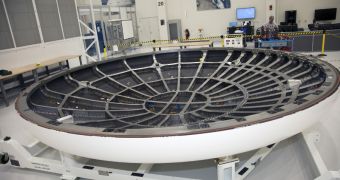Engineers with the NASA Kennedy Space Center (KSC), in Florida, are working hard to assemble the first Orion Multi-Purpose Crew Vehicle (MPCV), a spacecraft built specifically to carry astronauts to low-Earth orbit, the Moon, Mars, and near-Earth asteroids.
The Orion MPCV is now less than six months away from its maiden test flight, dubbed Exploration Flight Test-1 (EFT-1), which is scheduled to occur in May 2014. The spacecraft will take off aboard a Delta IV Heavy rocket from Space Launch Complex 37 at the Cape Canaveral Air Force Station, located right next door to the KSC.
During the flight, the vehicle will complete two orbits around Earth, and will then reenter the atmosphere at a very high speed, of around 32,186 kilometers (20,000 miles) per hour. The MPCV will make a soft, parachute-aided landing somewhere in the Pacific Ocean.
Orion will fly to an altitude nearly 15 times farther away from Earth than the International Space Station, at around 5,800 kilometers (3,600 miles). This will be the longest distance traveled by a spacecraft built for humans since 1972, Space reports.
At this point, KSC engineers are getting ready to outfit the Orion MPCV with its heat shield, which was delivered to the NASA facility earlier this month. The shield will protect the spacecraft during its high-speed reentry, when it experiences temperatures of up to 2,200 degrees Celsius (4,000 ºF).
Also in December, NASA experts outfitted the spacecraft with its three main parachutes, weighing in at 136 kilograms (300 pounds) each. In addition to these three main chutes, another 8 guide and drag parachutes are also installed on Orion, which will slow the capsule to a speed of 32 kilometers (20 miles) per hour before it splashes down in the ocean.
Officials at the United Launch Alliance say that the company's facility in Decatur, Alabama, is also nearing completion of the Delta IV Heavy rocket that will ferry the Orion into space. Once it enters active service, the capsule will be launched to orbit aboard the NASA Space Launch System (SLS).
The SLS is a heavy-lift delivery system that is scheduled to have its maiden flight in 2018. NASA hopes to use the SLS/Orion MPCV combo to explore a near-Earth asteroid by 2025, and then land on Mars by the early 2030s, all with a human crew. Orion can carry between 2 and 6 astronauts per trip.
In addition to exploring space beyond Earth's orbit, the capsule will also provide a back-up plan for resupplying the International Space Station, if needed. Currently, this task is handled by Russia, Europe and Japan, each of which sends regular robotic spacecraft to the ISS. The US contribution relies on two private companies, Space Exploration Technologies Corporation and Orbital Sciences Corporation.

 14 DAY TRIAL //
14 DAY TRIAL //